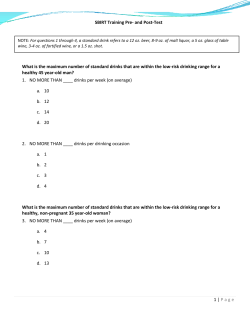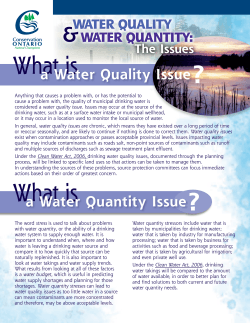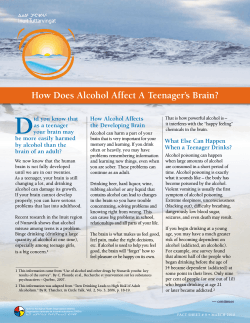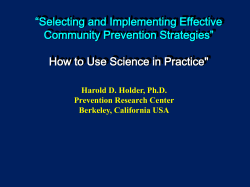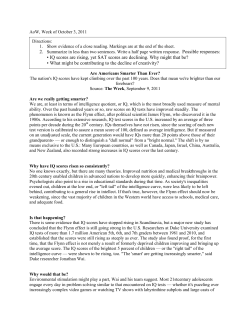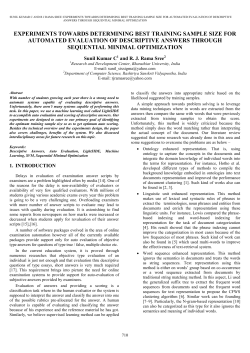
SAMPLE Assessment Summary XYZ Counseling Center
SAMPLE Assessment Summary XYZ Counseling Center Name: George Gender: Male Total Arrests, Drug/Alcohol Related: One Age: 40 Date of Offense: 02-15-09 Family History of Substance Use: Yes Presenting Problem: George is a forty-year-old Caucasian male who was referred by the court for screening and evaluation following his arrest for driving under the influence. Results of screening for a substance use disorder: Based on George’s high risk-taking behaviors and attitudes acknowledged on the BADDS and collateral information that was gathered during the DUI intake process, screening for a substance use disorder was warranted. Initial Screening: George was referred to XYZ Counseling Center by Judge Hap of the Springfield DUI Court to determine the extent to which George is at risk for impaired driving and if further assessment is warranted. As a standard intake procedure, all DUI offenders are administered the Behaviors & Attitudes Drinking & Driving Scale (BADDS), a brief questionnaire used to identify risk of future impaired driving as well as intervention effectiveness. George’s pretest scores were: RD 36 LA 24 LD 18 DB 1 George completed the Substance Abuse Subtle Screening Inventory (SASSI-3), a brief screener for substance use disorder that also gathers useful clinical information. The results follow. FVA 12 FVOD 3 OAT 7 SAT 4 DEF 5 SAM 6 FAM 8 COR 12 RAP 0 George’s SASSI-3 scores reveal that he has a high probability of substance dependence disorder. RB 0 BADDS Pretest Results: While George’s Riding Behaviors (RB) score indicates that he is at low risk for riding in a vehicle with someone who is impaired, his other scores reveal considerable risk for future impaired driving. George’s Rationalizations for Drinking & Driving (RD) and Lenient Attitudes (LA) scores fall within the high risk category. These scores suggest that George is inclined to agree with rationalizations and attitudes that support or promote impaired Lenient Attitudes Rationalizing (LA): (RD): driving. His 24 36 Likelihood RD Pre LA Pre of Drinking Low (0-10) Low (0-12) & Driving Moderate (11-20) Moderate (13-24) (LD) and High (21-40) High (25-48) Drinking & Driving Behaviors (DB) scores fall within the moderate range, revealing that George admits to having driven a vehicle while impaired and may be likely to do so again. SYM 6 From examining the face valid items that George endorsed on the SASSI-3, the following information was revealed: • Drinking has caused trouble on the job, in school, or at home. • Arguing with family and/or friends because of drinking has occurred. Continued on next page Likelihood (LD): Driving Behaviors (DB): 18 1 LD Pre High (31-60) 0 DB Pre Low (0-15) Moderate (16-30) Riding Behaviors (RB): RB Pre Low (0) Moderate (1-2) High (3 or more) Low (0) Moderate (1-2) High (3 or more) Interview: In the clinical interview, the counselor explained the test results and engaged him in further conversation about the extent to which his life has been negatively influenced by his alcohol and drug use. George reports that the drug use behavior is not a current concern, since this consisted of marijuana use before age 20, and none since then. George admitted that he has been confronted by his family on several occasions about his drinking, but that this is the first time that he has been in legal trouble because of it. He reported that he would comply with any court-ordered educational course or treatment plan. • Relationship problems (e.g. loss of friends, separation, divorce, etc.) have stemmed from his drinking. • He has tried to talk a doctor into giving him prescription drugs. • George admits to sometimes drinking too much. • He endorsed having used alcohol or “pot” too much or too often. • His father was/is a heavy drinker or drug user. • When he drinks or uses drugs he tends to get into trouble. • George’s drinking or other drug use causes problems between him and his family. Clinical Recommendation: The face valid items reveal the extent to which George Based on George’s BADDS and SASSI scores, theraacknowledges loss of control and experiencing negapeutic intervention is recommended. XYZ Counseltive consequences as a result of his substance misuse. ing Center recommends to the court that George George’s family and social system seems to be negaparticipate in a 6-week impaired driving education tively affected by addiction. These items also indicate course and an outpatient group therapy substance that family conflict is a significant consequence of his abuse program, for 3 drinking and/or drug use months. Some of the behavior. SASSI-3 Substance Abuse Subtle Screening Inventory issues to be addressed include control of his George’s OAT score, which George M 40 anger and impulses, as is elevated above the 85th 0 Adult Male Profile well as improving his percentile, as are his scores ability to manage feelings on the FVA and SYM scales, Check every rule, yes or no. of frustration. George’s suggests that he may have behavior and history of sufficient insight to undersubstance misuse has led stand that his alcohol use 12 3 6 7 4 5 6 8 12 to extensive issues involvbehavior is becoming a ing family and friends. problem for him in daily life. Engaging the family in the An elevated COR score of therapeutic intervention 12 shows a similarity in process may prove useful responses to other people in identifying whether who are involved in the family members are also criminal justice system who in need of assessment and also have alcohol and drug treatment and the extent problems. One should be to which they can provide cautious drawing conclusupport for George’s sions from this score but be THE DECISION RULE: HIGH PROBABILITY A rule answered "yes"? of having a Substance Dependence Disorder recovery. Finally, once open to considering possible LOW PROBABILITY George has completed similarities that may affect of having a Substance Dependence Disorder A rules answered "no"? the recommended interGeorge’s ability to respond ventions, completion of to a treatment program. the BADDS as a posttest should reveal the extent to which the intervention has been effective in reducing George’s risk for further impaired driving events. For free consultation on this profile 1-888 BY SASSI 1-888-297-2774 M-Th 8-6 Fri 8-5 EST Name Gender Case Number Age . Test date . RAP Random Answering Pattern FVA FVOD SYM OAT SAT DEF SAM FAM Correctional Family vs. Controls Supplemental Addiction Measure Defensiveness Subtle Attributes Obvious Attributes Symptoms Face Valid Other Drugs Face Valid Alcohol Check if RAP is 2 or more. Results may not be meaningful. Try to resolve problem before proceeding. Such profiles have an average decreased accuracy of approximately 20%. COR Scores 60 50 40 24 23 22 21 20 19 18 17 16 15 14 13 12 11 10 9 8 7 6 5 4 3 2 1 0 26 25 24 23 22 21 20 19 18 17 16 15 14 13 12 11 10 9 8 7 6 5 4 3 2 1 0 11 10 9 8 7 6 5 4 3 2 1 0 12 6 9 8 7 6 5 4 5 2 11 11 10 10 9 8 4 7 6 3 3 5 4 2 3 1 0 30 12 11 10 13 7 1 2 9 8 7 6 14 14 13 Percentile 90 70 1 Rule 2 FVA 18 or more? yes no FVOD 16 or more? yes no yes no OAT 10 or more? yes no SAT 6 or more? yes no Both? yes no FVA 9 or more OR ___and FVOD 15 or more SAM 8 or more ___. Both? yes no three? yes no 8 or more OR ___and 6 or more 2 or more ___and 4 or more ___and 4 or more ___. All four? yes no Rule T Score 80 Rule 12 13 11 12 10 11 10 9 5 8 4 7 3 6 2 5 98th 9 8 7 6 5 50th 4 3 2 1 0 Rule 4 Rule 5 Rule 15th Rule 7 or more ___and 5 or more ___. 7 8 OAT DEF SAM Rule SYM 7 or more? 6 OAT SAT Rule 85th 3 5 or more ___and 8 or more ___and 8 or more ___. All 9 FVA FVOD SAT DEF SAM NY LL ____Check if DEF is 8 or more. Elevated DEF scores increase the possibility of the SASSI missing substance dependent individuals. Elevated DEF may also reflect situational factors. Copyright © 1994, 1997 Glenn A. Miller v 97M 3/27/97
© Copyright 2025
